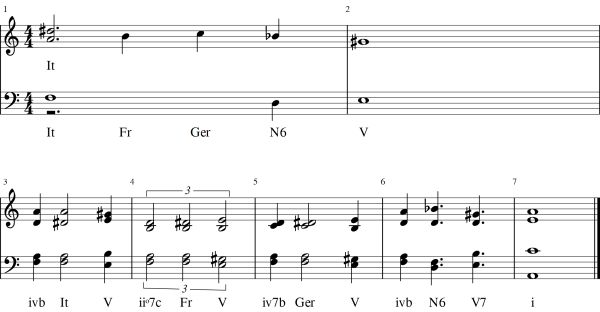Audio: chromatic chord (0:14)

chromatic chord plays chromatic chords on a vibraphone in the key of A minor. The chromatic chord figure shows the score:
A chromatic chord is a generic term in functional harmony for a chord that contains one or more chromatic notes.
A chromatic chord in functional harmony is often a precursor to modulation, a change of key. It can also be used without changing the key.
An augmented sixth chord forms a subgroup of chromatic chords that include the Italian sixth, French sixth and German sixth:
The Neapolitan chord is another chromatic chord. It differs from the augmented sixth chords in the way it is constructed. It is a supertonic chord with a chromatically altered root. In the key of A minor, the supertonic chord is iio, Bdim, and contains the notes BDF. Lowering the root by a semitone from B to Bb produces the chord BbDF, the Neapolitan (N). In first inversion the chord becomes DFBb, the Neapolitan sixth (N6), the final chord in the first bar of chromatic chord. It is typically used in minor harmony to expand a progression from a predominant chord to the dominant chord, as shown in bars 6-7.
The chromatic chords in first inversion all contain an interval of an altered sixth above the bass note. The 6 in their name refers to a sixth chord, which, in functional harmony, is shorthand for a first inversion chord. For example, the Neapolitan N6 indicates it is in first inversion, although it can be used in root position, in which case it is simply labelled N. However, a 6 in pop harmony and jazz harmony is used to notate a major sixth chord, which is an entirely different chord.
Functional harmony is not chromatic harmony. Using notes that are not part of the key weakens the aim of tonality. The four chromatic chords above all have a chromatic note as root which begs the question: what is the function of a chromatic note? There has never been a definitive answer to this question, or, rather, there are many answers, but little consensus. A chromatic chord is sometimes called a nonfunctional chord or a nondiatonic chord, which implies that it has no purpose. It is sometimes described as a linear chord, to emphasise its purpose is to harmonise a melody. Other labels that are used include chromatic auxiliary chord, passing chord and altered chord. The Neapolitan, in particular, is a mystery. It is a major triad, a consonant chord, built on the flat supertonic and occasionally labelled bII, yet its root is a chromatic note.
Probably the best that can be said about a chromatic chord is that it can either facilitate modulation or it can be used within a key to spice things up a bit and add variety, where it commonly functions as a predominant chord in minor harmony.